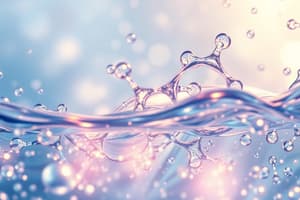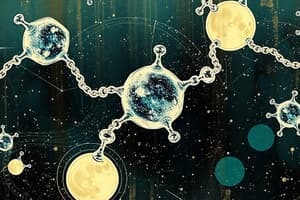Podcast
Questions and Answers
What type of interactions determine steric complementarity and stabilize biological macromolecules?
What type of interactions determine steric complementarity and stabilize biological macromolecules?
- Hydrogen bonds
- Covalent bonds
- Ionic interactions
- Van der Waals interactions (correct)
Which type of non-covalent interactions involve electrostatic interactions between permanently charged species?
Which type of non-covalent interactions involve electrostatic interactions between permanently charged species?
- Van der Waals interactions
- Ionic interactions (correct)
- The hydrophobic effect
- Hydrogen bonds
What is the complex phenomenon associated with the ordering of water molecules around non-polar substances?
What is the complex phenomenon associated with the ordering of water molecules around non-polar substances?
- Van der Waals interactions
- Ionic interactions
- The hydrophobic effect (correct)
- Hydrogen bonds
Which non-covalent interactions do not involve sharing a pair of electrons?
Which non-covalent interactions do not involve sharing a pair of electrons?
What is the geometry of the water molecule?
What is the geometry of the water molecule?
Why can water serve as both a hydrogen bond donor and acceptor?
Why can water serve as both a hydrogen bond donor and acceptor?
What induces a net dipole moment in the water molecule?
What induces a net dipole moment in the water molecule?
How many other water molecules can each water molecule connect to due to its dipole moment?
How many other water molecules can each water molecule connect to due to its dipole moment?
What does the pH of the solution equal at the midpoint of the titration curve?
What does the pH of the solution equal at the midpoint of the titration curve?
What characterizes the buffer region on the titration curve?
What characterizes the buffer region on the titration curve?
At what point in the titration curve is the acid most readily able to give up protons?
At what point in the titration curve is the acid most readily able to give up protons?
How can the pKa of an acid be determined using titration?
How can the pKa of an acid be determined using titration?
Flashcards are hidden until you start studying



